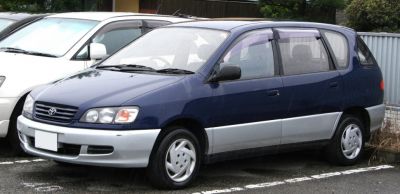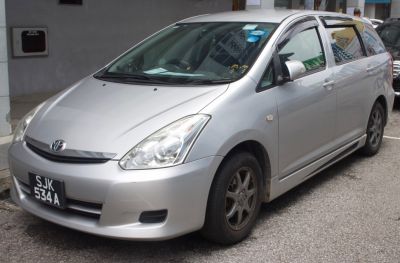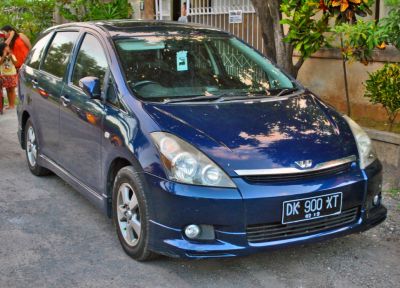 1996 Toyota Picnic (XM1) Dimensions, Size & Specs
1996 Toyota Picnic (XM1) Dimensions, Size & SpecsMeasurements of the 1996 Toyota Picnic, engineered for optimal performance and comfort
| Dimensions | |
|---|---|
| Length: | 4530 mm178.3 in14.9 ft |
| Width: | 1695 mm66.7 in5.6 ft |
| Height: | 1620 mm63.8 in5.3 ft |
| Trunk Capacity: | 180 liter6.4 cu ft |
| Trunk Capacity (Max): | 1840 liter65.0 cu ft |
| Weight Specifications | |
| Curb Weight: | 1335-1420 kg2943-3131 lbs |
| Maximal permitted Weight: | 2010 kg4431 lbs |
| Tire Specifications | |
| Tire Size: |
|
The Toyota Picnic (XM1) is a compact multi-purpose vehicle (MPV) or minivan produced from 1996 to 2001, designed as a practical family car with versatile space and manageable dimensions. Measuring 4530 mm (178.3 inches) in length, 1695 mm (66.7 inches) in width, and 1620 mm (63.8 inches) in height, the Picnic offers compact exterior dimensions well-suited for urban driving and parking, while still providing comfortable interior space. Its curb weight ranges from 1335 to 1420 kg (2945 to 3130 lbs), reflecting a balance between sturdy build quality and efficient size, with a maximum permissible weight of 2010 kg (4432 lbs). This weight capacity allows the Picnic to support passenger and cargo loads efficiently for typical family and small-group use. One of the key features of the Toyota Picnic (XM1) is its flexible luggage capacity: it provides 180 liters (6.35 cubic feet) of storage space with all seats in place, which expands dramatically to 1840 liters (64.97 cubic feet) when the rear seats are folded down. This substantial cargo volume highlights the vehicle’s versatility, making it ideal for long trips, shopping, and transporting bulky items. The 195/65 R14 tire size fitted to the Picnic helps ensure a balanced ride with good handling and comfort on various road conditions. Overall, the 1996-2001 Toyota Picnic (XM1) stands out as a practical, well-sized family minivan that offers ample interior space, flexible cargo options, and compact dimensions, making it a popular choice among MPVs of its era. Its dimensions and capacities make it a noteworthy reference point for those researching car size comparisons within the minivan segment of the late 1990s and early 2000s.
Discover the standout features that make the 1996 Toyota Picnic a leader in its class
Have a question? Please check our knowledgebase first.
The Toyota Picnic (XM1), produced between 1996 and 2001, measures 4530 mm (178.3 inches) in length, 1695 mm (66.7 inches) in width, and 1620 mm (63.8 inches) in height. This compact minivan size was designed to provide an optimal balance of interior space and exterior maneuverability.
The curb weight of the Toyota Picnic (XM1) ranges between 1335 kg to 1420 kg (2945 to 3130 lbs), depending on the variant and equipment. The vehicle's maximum permissible weight is 2010 kg (4430 lbs), reflecting the maximum load capacity including passengers and cargo.
With all seats in place, the Toyota Picnic (XM1) offers a modest luggage capacity of 180 liters (6.4 cubic feet), suitable for everyday shopping or small luggage loads. When the rear seats are folded down, this capacity dramatically increases to 1840 liters (64.9 cubic feet), allowing for substantial cargo space ideal for larger items and extended trips.
The Toyota Picnic (XM1) is equipped with 195/65 R14 tires. These mid-sized tires provide a good balance between ride comfort, fuel efficiency, and road grip, enhancing drivability and stability, especially for its class as a compact minivan.
Yes, the Toyota Picnic (XM1) fits comfortably into a standard garage. Given its length of 4530 mm (178.3 inches) and width of 1695 mm (66.7 inches), it can easily accommodate typical garage dimensions which often start around 5500 mm (216 inches) length and 2750 mm (108 inches) width, leaving enough room for opening doors and some additional storage.
At 1620 mm (63.8 inches) tall, the Toyota Picnic (XM1) sits comfortably in the lower to mid-range height for minivans. This moderate height assists with aerodynamic efficiency and ease of access for passengers, compared to taller minivans that may provide more headroom but can be less stable at high speeds or more cumbersome in urban settings.
The Toyota Picnic (XM1) replaced the previous generation, which had slightly smaller dimensions and less overall interior space. The XM1 saw an increase in length to 4530 mm (178.3 inches) and height to 1620 mm (63.8 inches), improving passenger comfort and cargo versatility. Width remained modest at 1695 mm (66.7 inches) for easy urban maneuvering. These updates made the XM1 more competitive in the compact minivan segment by enhancing practicality without significantly increasing exterior bulk.
When compared to contemporary compact minivans from the late 1990s, such as the Renault Scenic or the Citroën Xsara Picasso, the Toyota Picnic (XM1) is similar in length and height but slightly narrower. The slightly narrower width at 1695 mm (66.7 inches) helps in tighter city environments. Cargo capacity with seats folded at 1840 liters (64.9 cubic feet) is competitive, often exceeding some rivals' space, which emphasizes the Picnic's functionality in everyday family use.
Thanks to its 4530 mm (178.3 inches) length and relatively tall height of 1620 mm (63.8 inches), the Toyota Picnic (XM1) provides ample interior volume for passengers. It offers good headroom and legroom for its class, and the flexible seating configuration allows for family-sized loads and sizeable cargo. Even with seven seats in some markets, the vehicle balances passenger comfort and practical luggage space effectively. This makes it well suited for family trips or everyday urban needs.
The Toyota Picnic (XM1) has a curb weight ranging from 1335 kg to 1420 kg (2945 to 3130 lbs). This moderate weight helps in maintaining decent fuel efficiency for a minivan from the late 1990s. The relatively lighter curb weight compared to larger minivans assists in nimble handling and better braking response, contributing to safer driving. However, additional cargo or passenger load up to the maximum 2010 kg (4430 lbs) should be managed carefully to avoid underperformance or accelerated wear.
Discover similar sized cars.

| Production: | 1995-2001 |
|---|---|
| Model Year: | 1995 |
| Length: | 4530 mm178.3 in |
| Width: | 1695 mm66.7 in |
| Height: | 1620 mm63.8 in |

| Production: | 2005-2009 |
|---|---|
| Model Year: | 2005 |
| Length: | 4560 mm179.5 in |
| Width: | 1695 mm66.7 in |
| Height: | 1590-1600 mm62.6-63.0 in |

| Production: | 2003-2005 |
|---|---|
| Model Year: | 2003 |
| Length: | 4550 mm179.1 in |
| Width: | 1695 mm66.7 in |
| Height: | 1590-1600 mm62.6-63.0 in |

| Production: | 2001-2007 |
|---|---|
| Model Year: | 2001 |
| Length: | 4550-4570 mm179.1-179.9 in |
| Width: | 1695 mm66.7 in |
| Height: | 1590-1605 mm62.6-63.2 in |

| Production: | 2018-2021 |
|---|---|
| Model Year: | 2018 |
| Length: | 4615 mm181.7 in |
| Width: | 1735 mm68.3 in |
| Height: | 1660 mm65.4 in |
